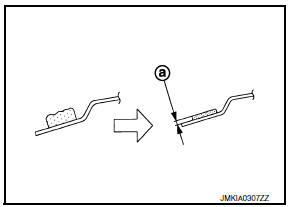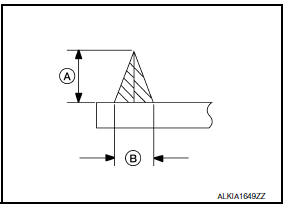Nissan Maxima Service and Repair Manual: Roof finisher
Removal and Installation
REMOVAL
- Open the glass lid.
- Apply protective tape around the roof side finisher to protect the surface from damage.
- Cut adhesive.
- Pass piano wire through the adhesive with a wire pierce.
- Tie piano wire on both ends to assist in wire grip.
- Pull piano wire with sawing motion to cut through adhesive, working along the length of the panel.
- Remove the roof side finisher.
INSTALLATION
WARNING:
- Keep heat and open flames away as primers and adhesive are flammable.
- The materials contained in the kit are harmful if swallowed, and may irritate skin and eyes. Never let them contact the skin or eyes.
- Use in an open, well ventilated location. Never breathe the
vapors. They may be harmful if inhaled.
Move immediately to an area with fresh air if affected by vapor inhalation.
NOTE:
- Use a genuine Nissan Urethane Adhesive Kit (if available) or an equivalent and follow the instructions furnished with it.
- Inform the customer that the vehicle should remain stationary until the urethane adhesive has completely cured (approximately 24 hours). Curing time varies with temperature and humidity.
- Using a knife or spatula, trim the adhesive (sealant) remaining on body down to approximately 2 mm thick (a) so that the contour becomes smooth.
CAUTION: If bonded area on body is scratched, be sure to repair it with a 2-component urethane. Do not use lacquer.

- When installing new roof side finisher, position the roof side finisher dry (no adhesive) first onto the vehicle and paint mating marks on the body and roof side finisher, then remove it again.
- Thoroughly clean bonding area on the roof side finisher and the body with isopropyl alcohol or equivalent.
- Apply primer to the body and the roof side trim (lower) surfaces.
- Apply adhesive to the contact areas of the body within the time specified in the instructions for the adhesive.
- Open adhesive by cutting off the nozzle tip and set it in a sealant gun.
- Form a continuous bead of adhesive resembling the measurements in applied thickness (A), and in applied width (B) on the body panel.

Adhesive applied thickness (A) : 13 +- 1 mm (0.51 +- 0.039 in)
Adhesive
applied width (B) : 8 +- 1 mm (0.31 +- 0.039 in)
- Position the roof side finisher, align the paint marks, then lower it into position.
- Press down lightly by hand to evenly expand the adhesive contact with the roof side finisher.
- Using a suitable tool, remove any adhesive overflow.
- Remove the protective tape.
 Sunroof unit assembly
Sunroof unit assembly
Inspection and Adjustment
INSPECTION
Wind Deflector
Open glass lid assembly fully.
Visually check for proper installation, damaged/deteriorated
components, or foreign objects within mec ...
 Front sunroof glass
Front sunroof glass
Removal and Installation
REMOVAL
Remove the wind deflector. Refer to RF-168, "Removal and
Installation".
Tape down the glass lid weatherstrip along the from sunroof glass
with protective ...
Other materials:
System temporarily unavailable
Condition A
When the radar sensor picks up interference
from another radar source, making it impossible
to detect a vehicle ahead, the FEB system is
automatically turned off.
The FEB system warning light (orange) will illuminate.
Action to take
When the above conditions no longer exist, ...
Forward-facing child restraint installation using LATCH
For additional information, refer to all Warnings
and Cautions in the "Child safety" and "Child
restraints" sections of this manual before installing
a child restraint.
Do not use the lower anchors if the combined
weight of the child and the child restraint exceeds
65 lbs (29.5 kg). If the c ...
Intelligent key system/engine start function symptoms
Symptom Table
Engine cannot be started with all Intelligent Keys.
CAUTION:
Follow Trouble Diagnosis Flowchart
referring to "SEC-4, "Work Flow"". Determine malfunctioning
condition before performing this diagnosis.
Check that vehicle is under the
condition shown in "Conditio ...
Nissan Maxima Owners Manual
- Illustrated table of contents
- Safety-Seats, seat belts and supplemental restraint system
- Instruments and controls
- Pre-driving checks and adjustments
- Monitor, climate, audio, phone and voice recognition systems
- Starting and driving
- In case of emergency
- Appearance and care
- Do-it-yourself
- Maintenance and schedules
- Technical and consumer information
Nissan Maxima Service and Repair Manual
0.0074
